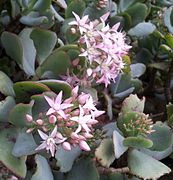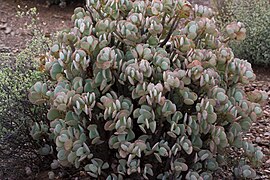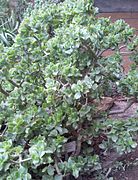|
Crassula arborescens
Crassula arborescens—the silver jade plant, silver dollar (jade) plant, beestebul, Chinese jade, cookie plant, money plant, or money tree,[2] that is endemic to Western Cape, South Africa, is a species of succulent plant in the family Crassulaceae. DescriptionIt grows into a 2 to 4 ft (0.6 to 1.2 m), succulent shrub. It has a single main trunk that can reach a diameter of up to 6 centimeters. The branches are thickened and gray-green in color. Shoots with leaves have a diameter of 7 to 10 millimeters. Unlike the related Crassula ovata (more commonly-referred to as 'jade'), C. arborescens has rounded, red-edged, gray leaves shaped like "silver dollars" or "cookies". Older shoots have a yellowish-brown bark that peels off that are divided into individual sections at the nodes. The flat and obovate to obovate-round leaves are 3.2 to 7 centimeters long and 2.3 to 4.2 centimeters wide. They are glaucous in color, have a powdery coating and are spotted with clearly visible water gaps. The leaf edges are reddish and the leaf base is wedge-shaped.[3] InflorescencesIt blooms in summer, with typical star-shaped Crassula white or pink flowers.[3][4] The terminal inflorescence consists of thyrses that are rounded at the top and is 5 to 8 centimeters high. It has a lot of dichasia. The 4 millimeter thick inflorescence stalk is 15 to 30 millimeters long and the flower stalk 10 to 12 millimeters long. The sepals are broadly triangular in shape. The star-shaped corolla reaches a diameter of 18 to 20 millimeters and is light pink or white. The lanceolate petals are 9 to 10 millimeters long and 2.5 to 3 millimeters wide. The stamens are 5 to 6 millimeters long and the purple-colored anther is less than 1 millimeter in size. The fruits are follicles, about 6 mm long and oval in shape, composed of 3-5 follicles each. Generally, even once dried, they remain attached to the plant and the seeds, which are small in size, will then be dispersed by the wind.[3] CultivationIt is cultivated as an ornamental plant for use in drought tolerant and succulent gardens, and in container gardens. It is also suitable for growing indoors as a houseplant if provided with full-exposure, sunny windows or grow lights, to prevent etiolation.[3] DistributionIt is native to the South African provinces of Western Cape, Eastern Cape and southern KwaZulu-Natal. The plants grow on dry rocky surfaces in the Succulent Karoo.[3] Gallery
References
|
||||||||||||||||||||||||||||||||||







